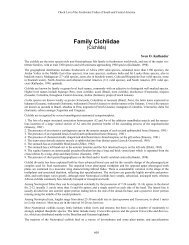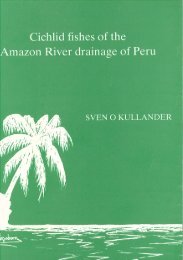Open Access PDF - Sven Kullander
Open Access PDF - Sven Kullander
Open Access PDF - Sven Kullander
Create successful ePaper yourself
Turn your PDF publications into a flip-book with our unique Google optimized e-Paper software.
380<br />
C. pinima, C. vazzoleri, and C. intermedia (Table 2).<br />
Among those C. pinima and C. vazzoleri are most<br />
similar in colour pattern.<br />
Most specimens of C. temensis have bilaterally<br />
continuous lateral line, whereas in C. pinima<br />
the common condition is to have discontinuous<br />
lateral line, and in C. vazzoleri almost all specimens<br />
have discontinuous lateral line. Unlike C. vazzo leri<br />
and C. pinima, C. temensis never develops dark<br />
ocellated blotches on the dorsum, and the vertical<br />
bars remain entire and at all sizes instead of at<br />
least bar 1 forming a distinct ocellated blotch. At<br />
some medium sizes, however, the dorsal blotches<br />
of C. vazzoleri may be overlooked and the<br />
general appearance is similar to C. temensis, e.g.,<br />
in the specimen shown in Figure 80, especially<br />
since the light spots along the side may be<br />
slightly elongate in C. vazzoleri.<br />
Even with a synonymy of six names, no type<br />
material is available for any of the nominal species<br />
and the synonymy of C. temensis has to be established<br />
on the basis of descriptions. As there is no<br />
difference in opinion between different recent<br />
authors as to the identity of C. temensis, and the<br />
published descriptions and figures for the nominal<br />
species included in C. temensis give a fair or<br />
strong idea of what species is considered, there<br />
seems to be no need for a neotype designation at<br />
this moment.<br />
The original descriptions of C. atabapensis and<br />
C. temensis (Humboldt & Valenciennes, 1821: 168-<br />
169) are very brief and there are no figures to<br />
facilitate recognition of the species. Humboldt<br />
writes (translated from the French):<br />
“I have noted in my diary two more species of<br />
Cichla [in addition to C. orinocensis], with the following<br />
characters.<br />
“Cichla atabapensis.<br />
“Pavon of Rio Atabapo: same form as Cichla orinocensis,<br />
but instead of four blotches, four transverse<br />
very broad, blue-black areas bordered with gold.<br />
It is also encountered in the portions of the Orinoco<br />
where the waters are not so fast; but the<br />
variety most agreeable for food is the one from<br />
the Rio Atabapo, a river with black, crystalline<br />
waters” (M. Valenciennes supposes, with reason,<br />
that C. atabapensis in my manuscript is C. ocellaris,<br />
Schneid., Pl. LXVI.)<br />
“C. temensis.<br />
“Pavon of Temi: same shape; no transverse bands,<br />
but four rows of small yellow spots. A single very<br />
large spot on the tail.<br />
“[Latin diagnosis, translated:] Green body, decorated<br />
with small yellow spots arranged in four<br />
longitudinal rows. A single large blue yellowmargined<br />
spot on tail.”<br />
It is thus evident that no specimens were ever<br />
preserved of either C. temensis of C. atabapensis.<br />
The species can be identified only with reference<br />
to the colour pattern in combination with the<br />
geographic distribution indicated by Humboldt.<br />
Of the species occuring in the area only one species<br />
displays a prominent pattern of four (or five)<br />
horizontal rows of yellow (or white) spots along<br />
the side (young and non-breeding adults, possibly<br />
breeding females) as well as three (although<br />
Humboldt counts four) prominent, wide, black,<br />
thinly light-margined vertical bars on the side,<br />
and that species is here identified as C. temensis.<br />
<strong>Kullander</strong> (2003: 621) placed C. atabapensis in the<br />
synonymy of C. temensis, thereby acting as first<br />
reviser, fixing the priority order of the names.<br />
The other species occurring or expected to<br />
occur in the upper Rio Orinoco area, C. orinocensis<br />
and C. intermedia, can be distinguished by their<br />
colour pattern. The former was correctly distinguished<br />
by Humboldt as C. orinocensis and is<br />
characterised by three prominent ocellar blotches<br />
on the side. Cichla intermedia has a series of several<br />
narrow vertical bars along the middle of the<br />
side. Amazonian species, particularly C. vazzoleri<br />
and C. pinima, would equally well suit Humboldt’s<br />
colour pattern description, but occur<br />
outside Humboldt’s collecting area.<br />
No types are preserved of either Cychla flavomaculata<br />
or C. trifasciata Jardine (1843), both reported<br />
from the Rio Negro and Rio Padauiri. The<br />
colour description and painting of C. flavomaculata<br />
agree with C. temensis, and there is no similar<br />
species with black bars and horizontal rows of<br />
light spots in the area:<br />
“The body is greenish lake, with three black<br />
bars, three rows and several scattered yellow<br />
spots; on the head several black spots, and a<br />
peacock-eye on the insertion of the tail. Dorsal<br />
fin and upper part of tail, indigo spotted with<br />
light blue; ventral, anal, and lower half of caudal<br />
fin vermilion; pectoral greenish; gill-rays vermil-<br />
<strong>Kullander</strong> & Ferreira: Review of Cichla




